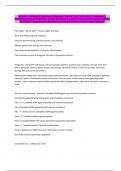Domain 2: Clinical Evaluation & Diagnosis: Special Tests NATA BOC, Goniometry,
Pathophysiology & Patho BOC Exam | Questions & Answers (100 %Score) Latest Updated
2024/2025 Comprehensive Questions A+ Graded Answers | With Expert Solutions
Pain types - Nerve pain➖ sharp, bright, burning.
Bone pain➖piercing and localized
Vascular pain➖aching, poorly localized, and referred.
Muscle pain➖ dull, aching, and referred.
Pain stops during activities ➖ chronic inflammation
Pain increases in joint throughout the day➖ progressive edema.
Endpoints - Normal➖ soft tissue: soft and spongy, painless, gradual stop. Capsular: abrupt, hard, firm
with a little give. Bone to Bone: distinct and abrupt, two hard surfaces come into contact. Muscular:
springy feel with some discomfort.
Abnormal➖ empty feel: movement beyond abnormal limit, pain before end of ROM (complete ligament
rupture). Spasm: involuntary muscle contraction that prevents motion due to pain (guarding, back
spasm). Loose: extreme hyper mobility (sprained ankle). Springy block: rebound at end point ( meniscus
tear).
Manual muscle testing - Normal 5 Complete ROM against gravity with maximal resistance
Good 4 Complete ROM against gravity with moderate resistance
Fair + 3 + Complete ROM against gravity with minimal resistance
Fair 3 Complete ROM against gravity with no resistance
Fair - 3 - Some, but not complete, ROM against gravity
Poor + 2 + Initiates motion against gravity
Poor 2 Complete ROM with some assistance and gravity eliminated
Poor - 2 - Initiates motion if gravity is eliminated
Trace 1 Evidence of slight muscular contraction; no joint motion
Zero 0 No muscle contraction palpated
Cranial Nerves - 1-Olfactory: smell
,2-Optic: vision
3-Oculomotor: eye movement
4-Trochlear: inferior and lateral eye movement
5-Trigeminal: sensation of the face and mastication
6-Abducens: lateral eye movement
7-Facial: facial expressions, taste
8-Vestibulecochlear: hearing and equilibrium
9-Glossopharyngeal: swallowing, salivation, and gag reflex
10-Vagus: swallowing and speech
11-Accessory: swallowing, sternocleidomastoid
12-Hypoglossal: tongue movement.
Neurological exam - Cerebral➖ questions that assess level of consciousness, intellectual performance,
emotional status, thought content, sensory, and language skills.
Cerebellar➖ coordination (finger to nose, heel toe walking)
Sensory Testing➖ peripheral nerves. Dermatomes (area of skin activated by a single nerve). Myotomes
(muscle group or a muscle innervated by a specific motor nerve)
Reflex Testing➖ deep tendon (stimulation of stretch reflex and results in involuntary muscle contraction
when tendon is stretched) superficial (skin stimulation at specific sites which produce muscle
contraction)
Inflammatory process - Inflammatory response, fibroblastic repair, maturationremodeling phase
Inflammatory response - Redness (rumor), swelling (tumor), tenderness (dolor), increased temperature
(calor), loss of function (functio laesa).
This is critical to the entire process.
Fibroblastic repair - Healing of proliferative and regenerative activity leading to scar formation and
repair. Scar formation begins within the first few days and lasts as long as 4-6 weeks. May be tender to
touch.
,Maturation Remodeling phase - A long term process. Realignment/ remodeling of cologne fibers that
make up scar tissue. May require several years to complete.
What is a clot made out of? - Fibrin
Edema - Increased pressure caused b swelling retards the healing process. It is best controlled and
managed during first aid management period.
Asymmetry - Lack of symmetry of sides of the body.
Atrophy - Wasting away of tissue or of an organ. A decrease in the size of a body part or muscle
Deformity - Malformation of a body part by birth or by an injury
Functional test - Determines if the athlete has full strength, joint stability, and coordination as well as
being pain free
Gait - Functional evaluation of someone's walking or running styles.
Step➖ sequence of events from a specific point in the gait of one extremity. Initial contact for both feet
Step length➖ linear distance covered by a step. One limb
Step width➖ distance between the points of contact of both feet
Stride➖ two sequential steps
Stride length ➖ distance covered by both limbs
Stance phase➖ the weight bearing phase of gait, starting on initial contact with the surface and ending
when contact is broken.
Swing phase➖ the non weight bearing phase, begins the instant the foot leaves the ground and ending
before initial contact of the ground again.
Stance phase➡️initial contact➡️loading response➡️midstance➡️terminal stance➡️preswing➡️swing
phase➡️initial swing➡️mid swing ➡️terminal swing.
, Sphygmomanometer - An instrument used to measure blood pressure. The inflatable cuff
Dynamometer - Hand held device to measure grip strength
Otoscope - Used for visual examination of the ear drum and passage of the outer ear
PO - By mouth
Q - Every
BID - Twice a day
QD - Once a day
TID - Three times a day
QID - Four times a day
PRN - As needed
NPO - Nothing by mouth
h. - Hour
h.s. - Bedtime, hour of sleep
Rotator cuff special tests - Empty can, full can, dropping sign, gerbers lift off sign, napoleons sign, pattes
test




